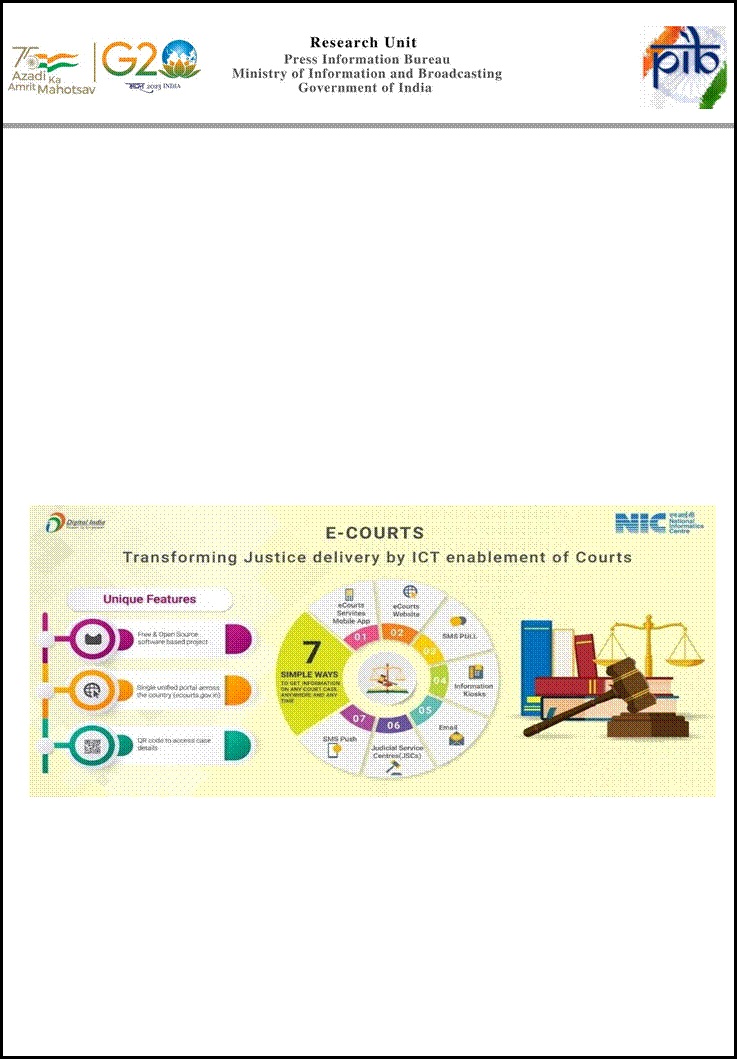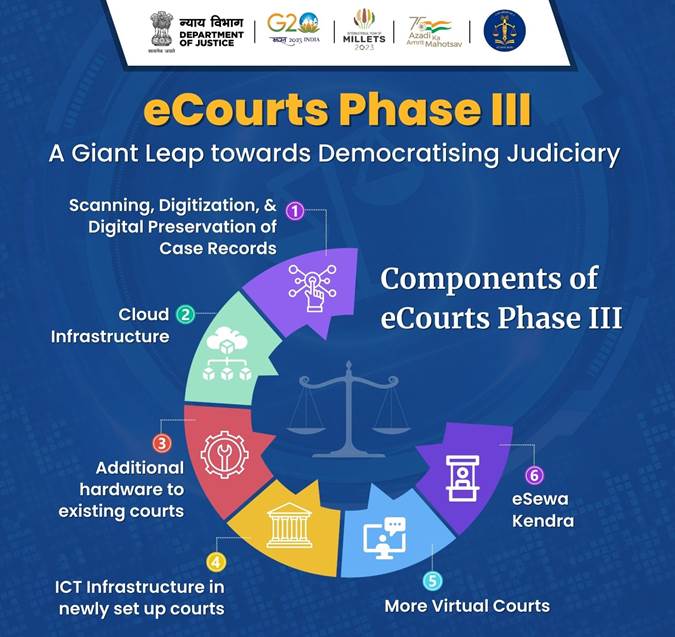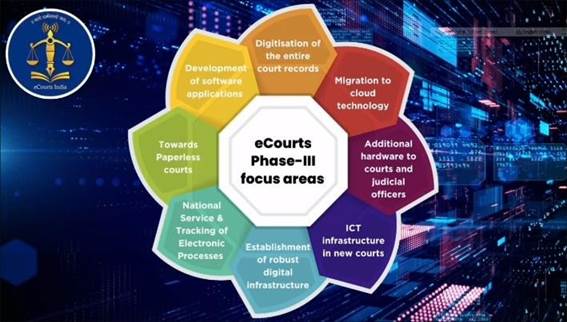
E-Courts Mission Mode Project
The Voice Chandigarh News:
The e-Courts Mission Mode Project is a flagship initiative aimed at leveraging Information and Communication Technology (ICT) for the modernization and development of the Indian Judiciary. Spearheaded by the Department of Justice, Government of India, this transformative project is being implemented in close collaboration with the e-Committee of the Supreme Court of India. The decentralized approach ensures that the project is executed effectively through the respective High Courts, enabling tailored solutions that address the unique needs and challenges of each judicial region. By integrating cutting-edge technology into the judicial framework, the project seeks to enhance transparency, efficiency, and accessibility in the justice delivery system across the nation.

The Union Cabinet chaired by Prime Minister Narendra Modi has approved the e-Courts Project Phase III as a Central Sector Scheme (2023 onwards) with a financial outlay of Rs. 7210 crore. The Phase II of the e-Courts Project has concluded in 2023. Phase III of the e-Courts Project in India is rooted in the philosophy of access and inclusion. It aims to usher in a regime of maximum ease of justice by moving towards digital, online, and paperless courts through digitization of the entire court records including legacy records, and by bringing in universalization of e-filing/ e-Payments through saturation of all court complexes with e-Sewa Kendras. It will put in place intelligent smart systems enabling data-based decision-making for judges and registries while scheduling or prioritizing cases. The main objective of Phase III is to create a unified technology platform for the judiciary, which will provide a seamless and paperless interface between the courts, the litigants, and other stakeholders.
Achievements of E-Courts Integrated Mission Mode Project
E-Courts Phase I: 2011-15
- Outlay: Rs. 935 Cr. Expenditure: Rs. 639.41Cr.
- 14,249 District and Subordinate Courts computerized.
- 13,683 Courts: LAN Installed
- 13,436 courts: Hardware provided
- 13,672 Courts: Software Enabled
· 14,309 JOs: Laptop provided
- Over 14,000 Judicial Officers were trained in the use of UBUNTU-Linux Operating System.
- More than 3900 court staff were trained in Case Information System (CIS) as System Administrators.
- 347 Jails and 493 Court complexes: VC (Video conferencing) Enabled
E-Courts Phase II: 2015- 2023
- Outlay: Rs. 1670 Cr. Expenditure: Rs. 1668.43 Cr.
· 18,735 District & Subordinate Courts computerized
- 99.5% of total Court complexes connected through WAN
- 1272 Jails and 3240 Court Complexes: VC enabled
- National Judicial Data Grid: Data Repository of orders, judgments, and case details of District & Subordinate Courts created as an online platform under the e-Courts Project.
E-Courts Phase III (2023-2027)
The Union Cabinet approved e-Courts Phase III (2023-2027) in September 2023, with an allocated outlay of Rs. 7,210 crore, which is over four times the funding for Phase II.

The project introduces various advanced digital measures, including:
- Establishment of Digital and Paperless Courts to digitize court proceedings.
- Comprehensive digitization of court records, including legacy records and pending cases.
- Expansion of video conferencing facilities to courts, jails, and hospitals.
- Broadening the scope of online courts beyond adjudication of traffic violations.
- Saturation of court complexes with e-Sewa Kendras for citizen convenience.
- Creation of a state-of-the-art Cloud-based data repository for secure storage and efficient retrieval of digitized court records.
- Implementation of software applications for live streaming and electronic evidence handling.
- Integration of emerging technologies such as Artificial Intelligence (AI) and its subsets like Optical Character Recognition (OCR) for case pendency analysis and forecasting future litigation trends.
These measures aim to enhance the efficiency and accessibility of the judiciary by ensuring ease of justice for citizens through convenient and hassle-free court experiences. By integrating technology with governance, e-Courts Phase III is determined to be a transformative initiative, setting a benchmark for the digitization of justice delivery in India

Initiatives Taken Under ECourts Project
- Under the Wide Area Network (WAN) Project, 99.5% of the court complexes across India have been connected with bandwidth speeds ranging from 10 Mbps to 100 Mbps.
- The WAN Project, which is part of the e-Courts initiative, connects all District and Subordinate Court complexes across the country using various technologies, including Multiprotocol Label Switching (MPLS), Optical Fibre Cable (OFC), Radio Frequency (RF), Very Small Aperture Terminal (VSAT), and Submarine Cable, creating a robust backbone for the e-Courts Project to ensure seamless data connectivity in the courts nationwide.
- Currently, 209 new court complexes are being connected by BSNL using Software-Defined Wide Area Network (SD-WAN) Technology.
- The National Judicial Data Grid (NJDG) is an online database containing orders, judgments, and cases from all computerized district and subordinate courts in the country, offering litigants access to case information and over 27.64 crore orders and judgments.
- A customized Case Information Software (CIS) based on Free and Open-Source Software (FOSS) has been developed. Currently, the CIS National Core Version 3.2 is being implemented in District Courts, while Version 1.0 is being rolled out in High Courts.
- As part of the e-Courts initiative, seven platforms have been set up to provide real-time updates on case status, cause lists, judgments, and more. These updates are sent to lawyers and litigants through SMS Push and Pull (over 4 lakh SMS sent daily), email (over 6 lakh sent daily), the multilingual e-Courts services portal (with 35 lakh hits daily), Judicial Service Centres (JSCs), and Info Kiosks.
- Additionally, Electronic Case Management Tools (ECMT) have been developed, including a mobile app for lawyers (which has been downloaded 2.69 crore times as of October 31, 2024) and the JustIS app for judges (with 20,719 downloads till the same date).
- India has emerged as a leader in conducting court hearings via video conferencing. As of October 31, 2024, the District & Subordinate courts heard 2,48,21,789 cases while the High Courts heard 90,21,629 cases (totaling 3.38 crore) using video conferencing system. The Supreme Court has conducted over 7.54 lakh hearings from March 23, 2020 to June 04, 2024 through video conferencing.
- Video conferencing facilities have been enabled between 3240 court complexes and 1272 jails across the country.
- Live streaming of court proceedings has been introduced in several High Courts, including those in Gujarat, Gauhati, Orissa, Karnataka, Jharkhand, Patna, Madhya Pradesh, Uttarakhand, Calcutta, and the Supreme Court of India, allowing media and other interested parties to participate in the proceedings.
- Virtual Courts have been launched in 21 States/UTs to handle traffic challan cases. These courts have handled over 6 crore cases, and in more than 62 lakh cases, online fines totalling more than Rs. 649.81 crore have been collected as of October 31, 2024.
- The e-Filing system (Version 3.0) has been upgraded to allow lawyers to access and upload documents for cases from any location, 24/7.
- The e-Payment system has been introduced as part of e-Filing, allowing for the electronic payment of court fees, fines, and penalties, which are directly paid into the Consolidated Fund.
- To bridge the digital divide, 1394 e-Sewa Kendras (Facilitation Centres) have been set up in District Courts and 36 e-Sewa Kendras in High Courts to provide services to lawyers and litigants, especially those in remote areas or unable to afford technology. These centres help citizens access e-Courts services, e-filing, virtual hearings, and more.
- The National Service and Tracking of Electronic Processes (NSTEP) system has been launched to enable technology-driven process serving and the issuing of summons, with implementation in 28 States/UTs.
- A new Judgment Search portal has been launched, offering free access to search judgments by various criteria, including Bench, Case Type, Case Number, Year, Petitioner/Respondent Name, Judge Name, Act, Section, Decision: From Date, To Date and Full Text Search. This facility is being provided free of cost to all.
- A total of 605 training and awareness programs have been conducted between May 2020 and October 2024, covering nearly 6.64 lakh stakeholders, including High Court judges, District Judiciary judges, court staff, master trainers, technical staff from High Courts, and advocates.
